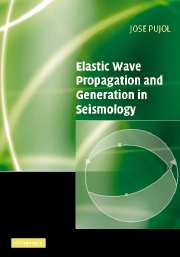Book contents
- Frontmatter
- Contents
- Preface
- Acknowledgements
- 1 Introduction to tensors and dyadics
- 2 Deformation. Strain and rotation tensors
- 3 The stress tensor
- 4 Linear elasticity – the elastic wave equation
- 5 Scalar and elastic waves in unbounded media
- 6 Plane waves in simple models with plane boundaries
- 7 Surface waves in simple models – dispersive waves
- 8 Ray theory
- 9 Seismic point sources in unbounded homogeneous media
- 10 The earthquake source in unbounded media
- 11 Anelastic attenuation
- Hints
- Appendices
- Bibliography
- Index
6 - Plane waves in simple models with plane boundaries
Published online by Cambridge University Press: 12 November 2009
- Frontmatter
- Contents
- Preface
- Acknowledgements
- 1 Introduction to tensors and dyadics
- 2 Deformation. Strain and rotation tensors
- 3 The stress tensor
- 4 Linear elasticity – the elastic wave equation
- 5 Scalar and elastic waves in unbounded media
- 6 Plane waves in simple models with plane boundaries
- 7 Surface waves in simple models – dispersive waves
- 8 Ray theory
- 9 Seismic point sources in unbounded homogeneous media
- 10 The earthquake source in unbounded media
- 11 Anelastic attenuation
- Hints
- Appendices
- Bibliography
- Index
Summary
Introduction
After the homogeneous infinite space, the next two simplest configurations are a homogeneous half-space with a free surface and two homogeneous half-spaces (or media, for short) with different elastic properties. The first case can be considered as a special case of the second one with one of the media a vacuum. In either case the boundary between the two media constitutes a surface of discontinuity in elastic properties that has a critical effect on wave propagation. To simplify the problem we will assume plane boundaries and wave fronts. Although in the Earth neither the wave fronts nor the boundaries satisfy these assumptions, they are acceptable approximations as long as the seismic source is sufficiently far from the receiver and/or the wavelength is much shorter than the curvature of the boundary. In addition, the case of spherical wave fronts can be solved in terms of plane wave results (e.g., Aki and Richards, 1980). Therefore, the theory and results described here have a much wider application than could be expected by considering the simplifying assumptions. For example, they are used in teleseismic studies, in the generation of synthetic seismograms using ray theory, and in exploration seismology, particularly in amplitude-versus-offset (AVO) studies.
The interaction of elastic waves with a boundary has a number of similarities with the interaction of acoustic and electromagnetic waves, so that it can be expected that a wave incident on a boundary will generate reflected and transmitted waves (the latter only if the other medium is not a vacuum).
- Type
- Chapter
- Information
- Elastic Wave Propagation and Generation in Seismology , pp. 129 - 187Publisher: Cambridge University PressPrint publication year: 2003



